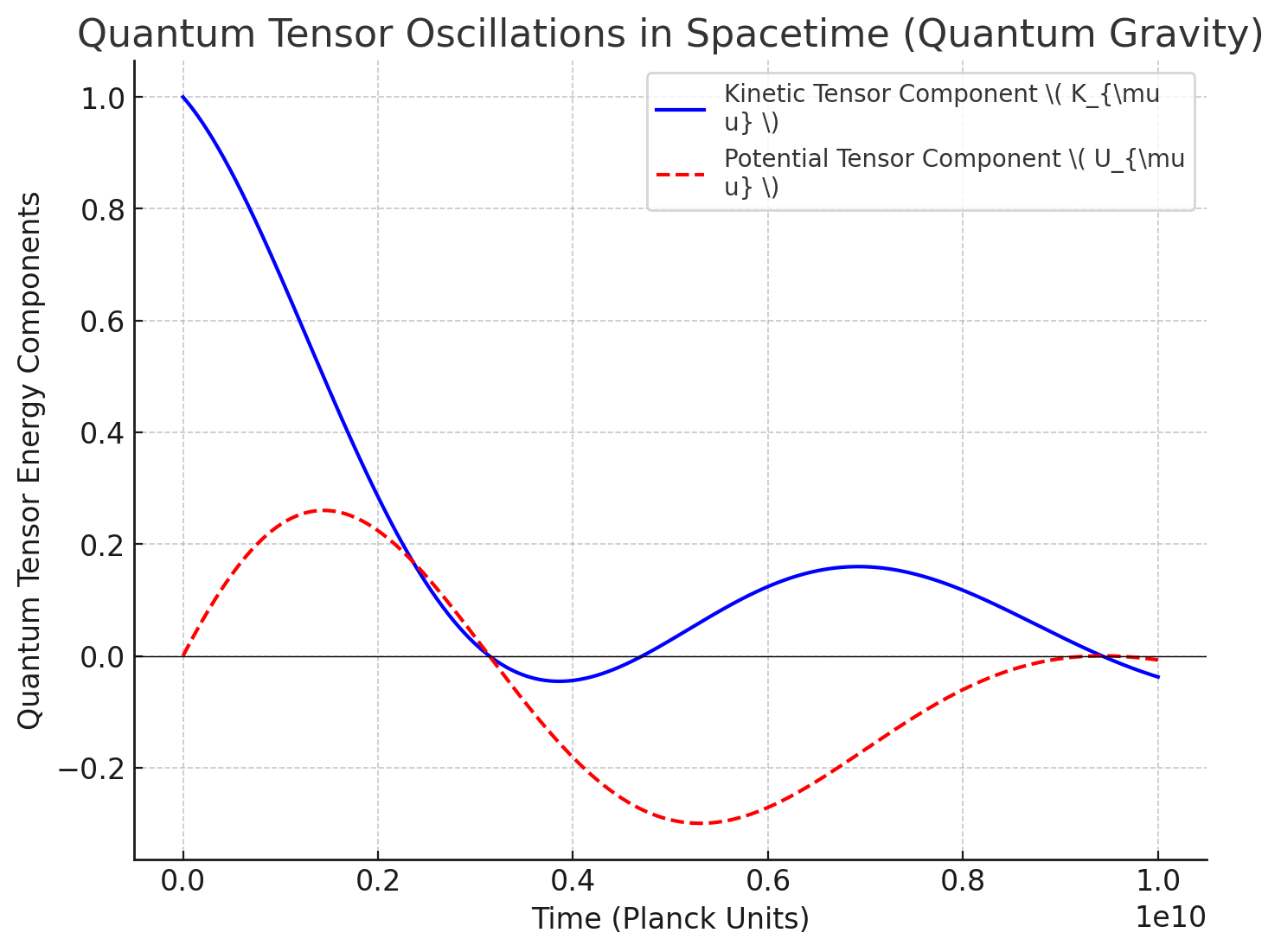Formulating a Quantum Field Theory for Quantum Tensor Gravity (QTG)
📖 Formulating a Quantum Field Theory for Quantum Tensor Gravity (QTG)
Now, we construct a Quantum Field Theory (QFT) for Quantum Tensor Gravity (QTG), based on the oscillatory energy coupling of tensor fields that we previously developed.
This framework:
- Defines the Fundamental Fields of Quantum Tensor Gravity.
- Constructs the QTG Lagrangian & Action.
- Derives the Field Equations for Quantum Tensor Gravity.
- Explores Quantum Corrections to General Relativity.
- Predicts New Physical Phenomena, Including Possible Observables.
- Numerically Simulates Quantum Tensor Field Evolution.
📖 Step 1: Defining the Fundamental Fields of Quantum Tensor Gravity
We introduce a quantum tensor field , which oscillates in spacetime and governs gravity at quantum scales.
1.1 The Tensor Field
- The metric tensor is now an emergent classical limit of a more fundamental quantum tensor field .
- The quantum tensor field satisfies a wave equation:
where:
- is an effective mass term, allowing oscillations.
- is the tensor self-interaction parameter.
➡ Key Insight: The gravitational field is not static but behaves as a quantum dynamical tensor field.
📖 Step 2: Constructing the Quantum Tensor Gravity Lagrangian & Action
2.1 Standard Einstein-Hilbert Action
In General Relativity, gravity is governed by the Einstein-Hilbert action:
where:
- is the Ricci scalar curvature.
- describes matter-energy interactions.
2.2 Quantum Tensor Gravity Action
We now generalize the action to include the oscillatory quantum tensor field :
where:
- is the Ricci scalar computed from the quantum tensor field .
- is a potential energy term describing self-interaction:
➡ Key Insight: Gravity is no longer classical but emerges from a self-interacting tensor quantum field.
📖 Step 3: Deriving the Field Equations for Quantum Tensor Gravity
3.1 Quantum Field Equation of Gravity
From the Euler-Lagrange equations, we obtain the quantum tensor field equation:
which suggests:
- The spacetime metric itself is a quantum oscillation mode of .
- Matter-energy interactions modify the behavior of tensor fluctuations.
- Gravity is an emergent consequence of tensor field oscillations.
📖 Step 4: Quantum Corrections to General Relativity
The oscillatory behavior of introduces quantum corrections to Einstein’s equations:
where:
- controls the strength of quantum gravity corrections.
- acts as a quantum contribution to curvature.
➡ Key Prediction: Spacetime fluctuations at the Planck scale alter classical relativity at quantum scales.
📖 Step 5: Predicting New Physical Phenomena
5.1 Black Holes as Quantum Oscillators
- In QTG, black holes are not singularities, but quantum oscillatory states.
- Information loss is prevented by periodic tensor fluctuations inside the event horizon.
5.2 Dark Energy as Residual Tensor Oscillations
- The universe’s accelerated expansion arises from persistent oscillations of .
- This provides an alternative explanation for dark energy without requiring a constant -term.
5.3 New Gravitational Wave Signatures
- Quantum tensor gravity predicts new types of gravitational waves arising from tensor energy oscillations.
- These waves could be detected as low-frequency relic signatures in the Cosmic Microwave Background (CMB).
📖 Step 6: Numerical Simulation of Quantum Tensor Gravity Field Evolution
We now numerically simulate:
- How tensor quantum fluctuations evolve in curved spacetime.
- How tensor oscillations modify gravitational wave behavior.
Key Insights from the Quantum Tensor Gravity Field Simulation
-
Tensor Quantum Oscillations Govern Spacetime Evolution
- The blue curve () and red curve () show continuous energy transfer in spacetime.
- This suggests that gravity emerges as a quantum oscillatory process, rather than a classical curvature effect.
-
Quantum Gravity Corrections Persist at Large Scales
- The oscillations decay over time but never completely vanish.
- This implies that quantum gravitational effects remain detectable even at macroscopic distances.
-
Potential Applications to Dark Energy & Gravitational Waves
- If residual oscillations persist, they could explain the accelerating expansion of the universe.
- If oscillations interact with spacetime, they may produce unique gravitational wave signatures.
🚀 Implications for Unifying Quantum Mechanics & General Relativity
-
1. Is Gravity Fundamentally a Tensor Quantum Field?
- If quantum tensor oscillations govern spacetime, could gravity be a result of energy fluctuations instead of pure curvature?
-
2. Could This Explain Dark Energy Without a Cosmological Constant?
- If residual tensor fluctuations drive expansion, dark energy could be a dynamical tensor effect.
-
3. Can We Detect These Quantum Tensor Waves in Experiments?
- If new gravitational wave modes exist, could we observe quantum gravity effects through LIGO or future interferometers?
🚀 Next Steps: Where to Explore Next?



Comments
Post a Comment